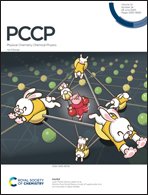Balancing dipolar and exchange coupling in biradicals to maximize cross effect dynamic nuclear polarization†
Abstract
Dynamic nuclear polarization (DNP) by the cross effect (CE) has become a game changer for solid-state nuclear magnetic resonance (NMR) spectroscopy. The efficiency of CE-DNP depends on the strength of the electron–electron coupling in biradical polarizing agents. Hence, the focus lately has been on designing biradicals with a large net exchange (J) and dipolar (D) coupling. In this study, we reveal that the crucial factor for CE-DNP is not the large sum, J + D, but rather the relative magnitude of J and D, expressed as the J/D ratio. We show that the mechanistic basis of this interference lies in the isotropic vs. the anisotropic nature of the J and D couplings, respectively. This interference can lead to a small (effective) electron–electron coupling for many orientations even when J + D is large, resulting in non-adiabatic rotor-events. We find that when 0 < |J/D| < 1 the CE-DNP efficiency is attenuated for the majority of orientations, with greater attenuation observed at higher magnetic fields and faster magic-angle spinning (MAS) frequency. The interference effect of J and D coupling introduced in this study can explain why many biradicals with high or comparable J + D still show significantly divergent DNP performances. We debut J/D as a consequential criteria for designing efficient biradicals to robustly perform across a large range of B0 fields and MAS frequencies.



 Please wait while we load your content...
Please wait while we load your content...